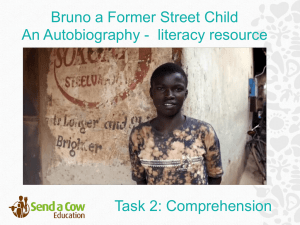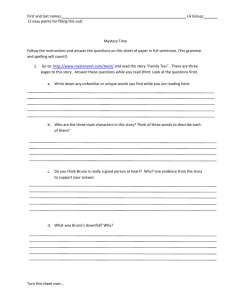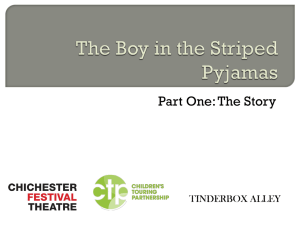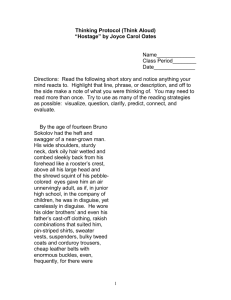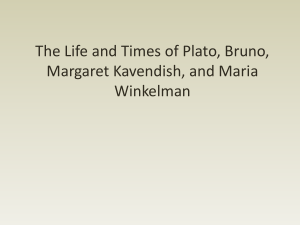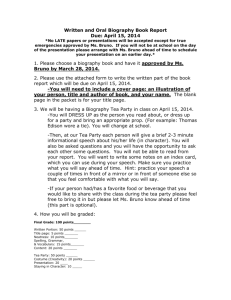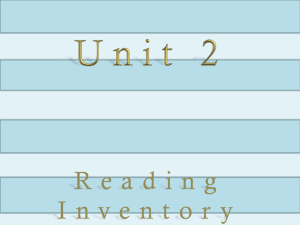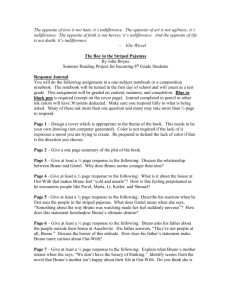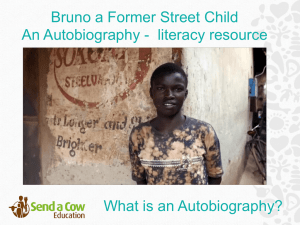chapter 16: drama
advertisement
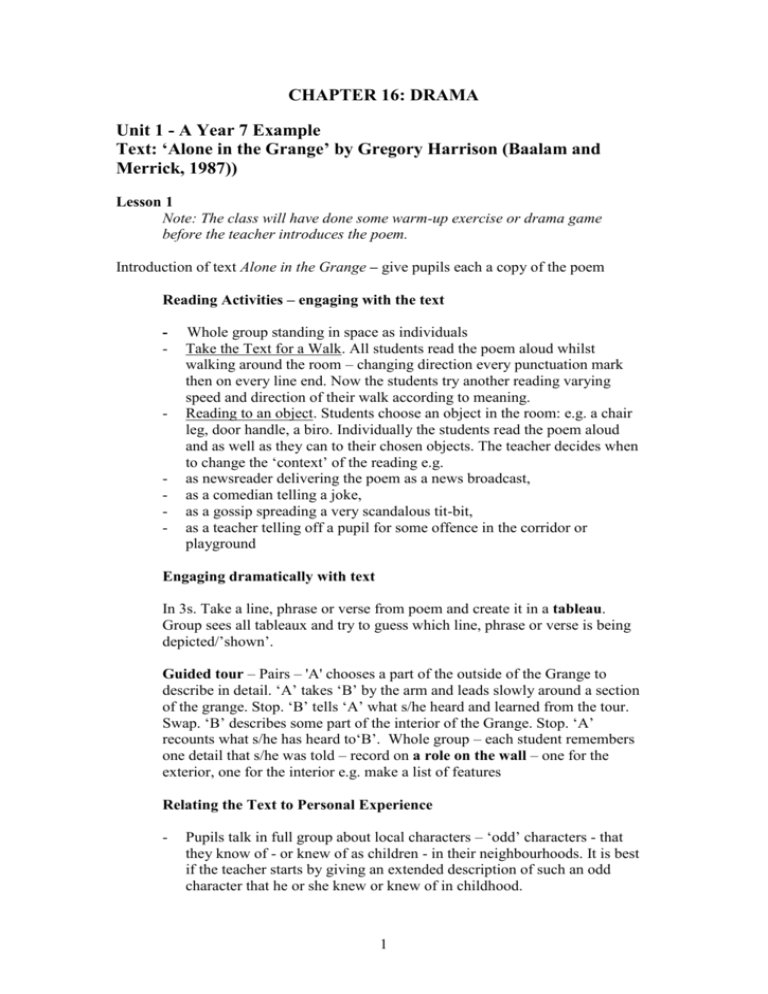
CHAPTER 16: DRAMA Unit 1 - A Year 7 Example Text: ‘Alone in the Grange’ by Gregory Harrison (Baalam and Merrick, 1987)) Lesson 1 Note: The class will have done some warm-up exercise or drama game before the teacher introduces the poem. Introduction of text Alone in the Grange – give pupils each a copy of the poem Reading Activities – engaging with the text - - - Whole group standing in space as individuals Take the Text for a Walk. All students read the poem aloud whilst walking around the room – changing direction every punctuation mark then on every line end. Now the students try another reading varying speed and direction of their walk according to meaning. Reading to an object. Students choose an object in the room: e.g. a chair leg, door handle, a biro. Individually the students read the poem aloud and as well as they can to their chosen objects. The teacher decides when to change the ‘context’ of the reading e.g. as newsreader delivering the poem as a news broadcast, as a comedian telling a joke, as a gossip spreading a very scandalous tit-bit, as a teacher telling off a pupil for some offence in the corridor or playground Engaging dramatically with text In 3s. Take a line, phrase or verse from poem and create it in a tableau. Group sees all tableaux and try to guess which line, phrase or verse is being depicted/’shown’. Guided tour – Pairs – 'A' chooses a part of the outside of the Grange to describe in detail. ‘A’ takes ‘B’ by the arm and leads slowly around a section of the grange. Stop. ‘B’ tells ‘A’ what s/he heard and learned from the tour. Swap. ‘B’ describes some part of the interior of the Grange. Stop. ‘A’ recounts what s/he has heard to‘B’. Whole group – each student remembers one detail that s/he was told – record on a role on the wall – one for the exterior, one for the interior e.g. make a list of features Relating the Text to Personal Experience - Pupils talk in full group about local characters – ‘odd’ characters - that they know of - or knew of as children - in their neighbourhoods. It is best if the teacher starts by giving an extended description of such an odd character that he or she knew or knew of in childhood. 1 - - A general sharing of these characters and experiences as the whole group sits in a circle. At this stage the teacher encourages the stereotypes and doesn’t push the pupils to see alternative or more empathic viewpoints – teacher tries to stay neutral but shows an interest. This can take up a substantial part of the lesson. Pupils are usually eager to tell the teacher all the strange and often lurid details of the characters and their behaviours. Lesson 2 Warm up/Starter Following a warm-up walking exercise or game the teacher groups the students in fours or fives. In that group the pupils devise and make a tableau of a word or phrase taken from the following list: Lonely, Isolated, Angry, Wasted, Defiant, Ugly, Lost, Obsessive, Closed, Secret, Resentful, Suspicious, Longing and Confused. Building the Stereotype Whole group – in space individually, comfortable – lighting subdued if possible– anything to aid focus. Teacher talks class through creating a character that lives in the same community as the old man in the grange: name, age, personality etc then, most importantly, their opinion and relationship, if any, with the old man. Each student assumes the character, history, opinions and relationships of a village resident. All think of a line, in character, that sums up how that person feels about the old man e.g. ‘He stinks’, ‘I think people should leave him in peace.’ The teacher can now thought track the group – touching individuals’ shoulders – they then say their line. Gives teacher time to select a group of contrasting opinions and standpoints. ‘Conscience Corridor’ is an interesting way of hearing all these perspectives in a dramatic context. Option at this point... You can readily extend the drama into a meeting convention at this point. As teacher in role as Local Vicar (empathetic) or Chair of Residents Association concerned at the general dilapidation of the grange and rumours about the old man’s activities (antipathetic/hostile) teacher-in-role convenes a meeting of local residents to discuss the grange and its mysterious owner/tenant. Breaking the Stereotype - Hot seat a few of the characters that have emerged. Some should be sympathetic – even if you have to create these characters yourself. Agree with the class that they accept or agree all they hear and that they must use the information given to build up a picture of the old man. You will need to keep summarising the key points in the old man’s history for the group. I like to record the details that we agree. It means that we can edit or change things if there are contradictions or disagreements. 2 - - The drama becomes quite fluid here. Incidents and characters come to life e.g. deceased wife, estranged children, old friends, workmates etc. Don’t worry about using all the initial characters – go with the flow and hot seat the characters that come into the story. Summarise what the group has learned and decided. You are now in a position to draw up a time line of the old man’s life with key moments, events and relationships marked on the line. Lesson 3 Warm-up/Starter - - Spread group around the room in role as the old man. They will be ‘pottering’ around the house doing something very ordinary. Give the students a series of everyday routines to mime e.g. making tea, reading the paper, ironing, washing up, making a bed. Look at some of the mimes Ask the students to choose one of their mimes and work hard at perfecting it. Whilst the mimes are in progress ask the class to think of a thought that is constantly running in the old man’s head as he does his chores. It could be a short line or phrase or it could be a longer more complex or confused stream of memories and feelings. Teacher thoughttracks some who will say aloud their thoughts as they continue the mime – this will help reinforce aspects of the agreed history. Action and Re-action - - - Still working individually, explain to the group that the old man is about to be interrupted. The old men are about to hear some shouting from outside directed at them. When the shouting/banging begins they must freeze their mimes. The teacher sets up shouting and banging – keeping the identity of the caller(s) open at this stage and concentrating on the old man’s reaction. Still image/freeze-frame and hold statues of how he feels at the interruption. Divide the group and do a ‘gallery of statues’ exercise. You can now go back to the caller. Who is it or who are they? Here are some of the possibilities that might be suggested: an old friend, an estranged child, a social worker, a newspaper reporter, a property developer eager to buy the house, a local council official, a confidence trickster. These can be hot-seated and/or the drama can move on into improvisation and forum theatre from there. Students in pairs or threes improvise the encounters between the old man and the caller(s). These can be worked on and some may be seen and evaluated. Additional Lesson Material - The teacher provides a collection of personal artefacts/objects belonging to the old man. 3 - - - Place the artefacts on the floor and introduce them to the group. There should be sufficient for each group of 4 or 5 students to have one artefact. In 4s or 5s the pupils choose an artefact/object and discuss its place in the old man’s life. They should discuss/devise a scene in which the artefact played a key part. Bring the groups back in order to hear and to sequence the incidents into the old man’s life. Explain that each scene will be sequenced in order through the old man’s life and that you will use a physical object as a ‘baton’ to signal the end of one group’s scene and the start of the next. Teacher can use a suitably appropriate object as the baton: a key, a watch an egg-timer. Arrange the groups around the room in a chronological order – like the markings on a clock. Groups then work on their improvised or devised scene involving the artefact. Each improvisation must begin and end in a freeze-frame. Then the pupil playing the old man takes the baton and places it on the floor in front of the next group chronologically. The old man character takes the baton – once the baton is in place the improvisation comes to life – and so on to the latest scene from his life when finally the last old man places the baton on the floor in the middle of the room. 4 Alone in the Grange Strange, Strange, Is the little old man Who lives in the Grange Old, Old, And they say that he keeps A box full of gold. Bowed, Bowed, Is his thin little back That once was so proud. Soft, Soft, Are his steps as he climbs The stairs to the loft. Black, Black, Is the old shuttered house, Does he sleep on a sack? They say he does magic, That he can cast spells, That he prowls round the garden Listening for bells; That he watches for strangers, Hates every soul, And peers with his dark eye Through the keyhole. I wonder, I wonder, As I lie in my bed, Whether he sleeps with his hat on his head? Is he really a magician With altar of stone, Or a lonely old gentleman Left on his own? Gregory Harrison 5 Unit 2 – A Year 9/10 Example Text – ‘The Boy in the Striped Pyjamas’ by John Boyne, (Oxford University Press, 2006) See Appendix B Lesson 1 Note: The class will have done some warm-up exercises or drama games before the teacher introduces the drama. Orientation/Starter * Organise the students into groups of three/four Sit down. Each person thinks about and tells the group about a time when they experienced upheaval or change as a child: e.g. moving house, moving school, moving country. How did they understand the disruption? How did they make sense of what was happening? Each student tells the story of what happened to him/her. As a group pick a moment from one of the stories and make a tableau of that moment. Choose a line from the story or write a line or two that will be read as a caption at the start of the tableau and at the end. Reading Activities Ensure students can read Extract A. Take the text for a walk – students read the text aloud as the walk around the drama room avoiding each other. Ask students to change direction every time they reach what they consider to be a key word. Choose and learn a phrase; between three and six words. Walk around saying the phrase to yourself – walk and adopt a style, shape and mood in your walk that fits the phrase. Carry on but now use the phrase as a greeting with all you meet/pass. Shake hands, give your phase and receive one at each meeting. Engaging Dramatically with Text (a) In pairs or as a full group. Tableau of the moment when Bruno enters the room. If done as a whole class the rest of the class sculpt the two characters into an agreed ‘best’ still image/freeze-frame. This is going to be photographed and used as a still or poster image for a film of this book – this is the opening of a book. Also Present … Now place two other unseen characters into the tableau. - The reader – is the reader feeling closer to Bruno or to Maria? - The writer – Where is the writer? Whose perspective is the writer taking or does it change? (b) In pairs or full group. Sit with partner back to back or place two chairs in the centre of the circle. Assign pupils as ‘A’ or ‘B’. A is Bruno, B is Maria. We are going to give these actors a script of just 3 lines each. These six utterances are going to be complete in themselves they will represent the beginning, middle and end of the conversation between the two characters. Nothing more 6 will be said in this scene. Bruno will speak first. What will he say? Suggest content, suggest wording, suggest amendments – try it out. When you’re happy with the first utterance then go on to script Maria’s reply. It cannot be silence. Work through the six line script in this way, rehearsing it cumulatively so that the pairs/actors can remember it each time. When you’re happy with the full script you can add any background soundscape effect. (c) Full group circle. Now the ‘script’ actors/ or each pair one by one go and stand outside the circle. Two other students take up the still-image/freeze-frame position – practised earlier – positions must be agreed by the whole group. When class is happy with the framing, the actors freeze and the ‘script’ actors stand behind their character but outside the circle. Start the background soundscape effects, run the script and just leave the sound effect to fade for a finish. Lesson 2 Orientation/Starter - - - Students stand in space. Ensure that all students can see Extract B. Take the text for a walk as Lesson 1 above – continue until all students have read passage at least twice. Tell the class that Gretel is Bruno’s sister. Answer questions about the extract but do not answer questions that will compromise the drama to follow e.g. the father’s occupation. Students might speculate about what he does but teacher shouldn’t confirm or refute any ideas at this stage. Letters/Texts. Explain that Mother has just appeared in the doorway of Bruno’s bedroom. She is carrying a piece of paper with writing on it. In groups of three make a tableau of the moment that Mother appears and Bruno sees her. You need Bruno, Maria and Mother. What is this piece of paper/text? How is Mother holding it? Why? Do Bruno and/or Maria know what the paper is? What is written on it? Show the resulting tableaux and discuss what the various group thought the text was. What part do they think the text might play or have played in the lives of the characters? Record the ideas. Engaging Dramatically with the Text - - Place 5 chairs in the middle of the room facing in one direction. Full group of students should stand facing the chairs. Assign a chair as each of the following characters: Bruno, Maria, Gretel, Mother and Father. Make sure that each chair is labelled as a character. Ask a student (or gather collective agreement and teacher do the moving of chairs) to move the chairs according to what we have found out so far about the relationships between the five characters. For instance, is Bruno’s chair closer to Maria than to Gretel? Teacher can allow chairs to be moved so that they face a different direction if it seems appropriate e.g. some characters may ‘look towards’ some and ‘turn away’ from other characters. Try to reach an agreed configuration for the line of chairs. Captioning. Teacher places a large sheet of paper at the base of four of the chairs. At this point the teacher removes the Gretel chair. On the top of each 7 - sheet is written, ‘I am very worried that …’ Students, in pairs, re-read Extract B closely. The students complete this statement for each character with a short phrase. When all the phrases are written down the teacher should read some of each character’s statements e.g. Bruno: ‘I am very worried that … Maria will show Mother my private things’. Some will be conflicting: try to reach an agreement on one statement for each character. In the light of these statements the chairs can be adjusted by general agreement. Engaging Dramatically with Text - - - Imagine that immediately following this extract Bruno goes to find his sister Gretel. What would he talk to her about? What would Mother say to Maria immediately after this extract? In groups of 4 students improvise these two different and separate conversations. The pairs should work separately at first developing the scenes and the dialogue between the pair of characters: Maria and Mother, Bruno and Gretel. When the scenes have been devised the pairs should show the scenes to their partner pair. Now the students work as four and their task is to show the two scenes happening simultaneously be freeze framing on one scene whilst the other scene comes to life. The students think hard about where they make the scene shifts. Students then rehearse their full, interlinking scenes. Each piece should begin and end with both pairs frozen. The finished scenes should be performed and evaluated. Lesson 3 Note: The class will have done some warm-up exercise or drama game before the teacher introduces the Orientation. Orientation - - In groups of varying sizes: 3, 4, 5, 6 students construct spontaneous tableaux to represent some or all the following themes that have relevance to the text: Powerless, Respectful, Confused, Embarrassment, Responsibility, Fear. Show as many of these as time allows and discuss how different groups have represented them physically and visually. Look at the two text extracts that you’ve worked with so far and identify where the feelings that have been represented are present in the text – where the reader can infer that a character(s) is feeling powerless, respectful etc. In the full group circle students can volunteer to represent these moments in tableaux and can now be sculpted by other students or the full groups to show the effect of the feelings on the character(s) and the action. Reading and Engaging - Read Extract 3. In pairs discuss what we learn from the extract about the Mother, the Father and their relationship. 8 - - - Moment Before/Moment After. In pairs make three still images/freeze frames from the film of this extract. The first image should show the Mother and Father frozen in the moment before the Mother enters the Father’s office. The second image should show the Mother and Father in the office at the moment when the Father ‘put a stop to the conversation’. The third image will show both protagonists as the Mother closes the office door behind her as she leaves. Show, discuss and evaluate some of these. Full group circle. Ask one of the pairs to re-create their second still-image in the middle of the circle. Also Present … Now discuss and place Bruno into these pictures. Where would he be positioned in terms of his Mother and Father? Are there any clues in what we’ve read? When the group is happy with Bruno the same process should be undertaken for Maria and Gretel. Discuss and agree the resulting configuration. Also Present … finally add the Writer and the Reader and place into the picture the Letter/Text that we introduced and discussed in Lesson 2. Final Ensemble Exercise - Essence Machine and Soundscape. Explain the idea of the Essence machine and Soundscape exercises. Make and discuss three machines: Mother, Father and Bruno 9
